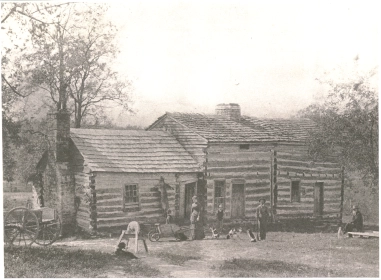
The presence of permanent non-Native American residents in what is today O’Fallon can be substantiated as far back as 1796 when Jacob Zumwalt accepted Spanish land grant #55. The land grant consisted of 450 arpents (383.8 acres) and was located on both sides of Belleau Creek. Today’s Fort Zumwalt Park sits on a portion of this original land grant. The reconstructed Zumwalt’s Fort sits in the park and provides a glimpse of what life was like for the Zumwalt family.

The history of the Zumwalt family and their homestead fort is a microcosm of American westward expansion and a tribute to the early settlers who came to the area in order to create a better life for themselves and their families, a process which still continues to this day. Jacob and his brother, Christopher Zumwalt, moved their immediate families first and five additional Zumwalt brothers followed them later. Local legend has it that Daniel Boone helped his friend, Jacob, locate his homestead at the brink of a hill that had a fresh spring below. Jacob was also a Revolutionary War veteran, one of only a few who settled in St. Charles County.

The Zumwalt family originally came from Pennsylvania and they spent time in Kentucky before finally settling in St. Charles County. Jacob and his family are believed to have built the first hewn log house north of the Missouri River. With help from extended family, the first section was completed in 1798, and additions were made in succeeding years. The cabin’s four generously sized rooms, hewn log walls, stone foundation, plank floors, a double fireplace and other details of substantial Pennsylvania German construction set the house apart from others. Jacob helped brother Christopher build a mill and brother Adam operated a distillery. Both of these properties were closer to the area that is now St. Paul.
 The Zumwalt family were Methodist and the first Methodist sacrement in Missouri was administered in the Zumwalt home by Rev. Jessie Walker in 1807. It is also believed that when Jacob’s with Catherine died on the homestead in 1799 her burial was the first christian burial in the area. With no Methodist church nearby, her death was recorded in local Catholic records. Jacob lived on the homestead for nineteen years, and raised ten children from two wives. He moved on to Pike County, Missouri with one of his sons in 1817. He passed away there three years later.
The Zumwalt family were Methodist and the first Methodist sacrement in Missouri was administered in the Zumwalt home by Rev. Jessie Walker in 1807. It is also believed that when Jacob’s with Catherine died on the homestead in 1799 her burial was the first christian burial in the area. With no Methodist church nearby, her death was recorded in local Catholic records. Jacob lived on the homestead for nineteen years, and raised ten children from two wives. He moved on to Pike County, Missouri with one of his sons in 1817. He passed away there three years later.

The Zumwalt home was one of the largest in the area at the time. It was refered to as Zumwalt’s Fort because neighbors would gather their for protection from raids at this “homestead fort” during the War of 1812. There were a total of seven homestead forts in St. Charles County and three were located in or near O’Fallon. The other two being Pond Fort off Highway N in Dardenne Prairie, and White’s Fort in Dog Prairie (St. Paul area). As many as ten families found refuge within one of these properties during the hostilities which were characterized by quick penetrating Indian raids against settlements along the Missouri and Mississippi Rivers. Fighting ended in Missouri by July 1815 when peace treaties were signed at nearby Portage des Sioux.
Legend has it that before the War of 1812, Black Hawk, a Sauk chief noted for his dignified manner, regularly bought whiskey from Adam Zumwalt, who lived about six miles from Zumwalt’s Fort, and danced with his daughters. During the War of 1812, Black Hawk and a band of warriors fought U.S. Rangers to a draw at the Battle of the Sinkhole in Lincoln County off present-day Highway 79 just north of Old Monroe.
The War of 1812 ended with the Treaty of Ghent in 1814 and after the local treaties were signed with the Native Americans at Portage des Sioux, it opened the floodgates to a tide of immigration from the eastern states and Europe. For the next twenty years, virtually all westward migration funneled through St. Charles and passed through present-day O’Fallon. The settlers’ homes were generally far apart and the mills and trading points were far apart as well.